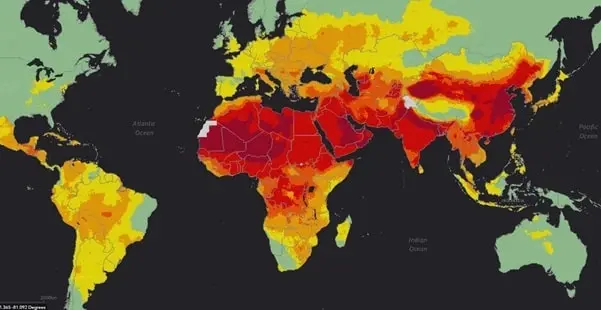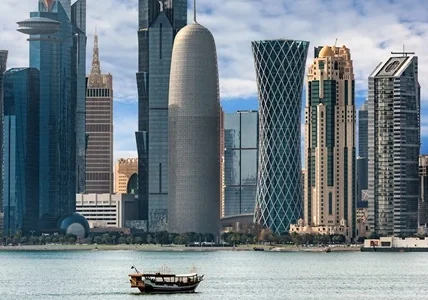Pollution is by far the biggest issue we are facing as a human race in the 21st century. There are many reasons for the increasing pollution, but it has been seen that developing countries tend to be more polluted in the world. And that is pretty much the case in the current times. If you want to know which are the most polluted countries in the world right now, then keep on reading this post. That’s because we are here to take a good look at the 10 most polluted countries in the world as of 2024. Here we go.
1. Bangladesh
Can you believe it? Bangladesh tops the charts as the most polluted country in the world, with an average PM2.5 concentration of 79.9 µg/m³ in 2023-24. The main causes of that are rapid industrialization, vehicular emissions, and incredibly high dependence on fossil fuels, which is pretty common in most polluted countries. And it is actually Dhaka, the capital of the country, where pollution is worst at 83.3 µg/m³ in the air and a rise specifically during the winter months that coincide with vehicle emissions, industrial work, and the use of brick kilns.
2. Pakistan
Pakistan isn’t far behind, ranking high with an average PM2.5 concentration of 73.7 µg/m³ in 2023-24. Add to it an urban population of around 235 million people, and the problems multiply. Lahore is the worst off at 97.4 µg/m³, with a PM2.5 concentration. Karachi is another victim of industrial activities, traffic emissions, and the production of steel and bricks. The major culprits? Old, poorly maintained vehicles and low-grade fuels, plus industrial emissions, particularly from steel and brick production.
3. India
India is one of the most consistently polluted countries, with an average PM2.5 concentration of 54.4 µg/m³ in 2023-24. The problem is elevated by high urban densities, you know, with more than 1.4 billion people, the population is one big reason behind this level of air pollution in the country. And as you may know, the air quality in Delhi is famously terrible. And yes, industrial emissions from coal-using factories and agricultural residue burning, especially in Punjab and Haryana, cause severe pollution spikes in winter.
4. Tajikistan
Tajikistan records an average PM2.5 of 49.0 µg/m³, and it falls in the category of highly polluted countries as per the 2023-24 report. The capital, Dushanbe, is one of the most polluted cities, and this worsens during winter, as coal, vehicular emissions, and industrial activities increase the level of pollution. Khujand is also characterized by the element of high pollution. Old vehicles, low-quality fuel, and factories using coal are some of the main pollution sources here.
5. Burkina Faso
Burkina Faso ranks among the top five most polluted countries with an average PM2.5 concentration of 46.6 µg/m³ in 2023. The capital, Ouagadougou, is the most polluted city because of vehicle emissions, industrial activity, and frequent dust storms. The main sources of PM2.5 in the country are aged vehicles, low-quality fuels, and industrial smoke, particularly emitted from coal-burning plants. And as any of us can speculate, this causes a lot of health problems like cardiovascular diseases, lung cancer, and other serious health conditions.
6. Iraq
The average PM2.5 concentration for Iraq is 43.8 µg/m³ as per the 2023-24 air quality index report. With a population of about 44.5 million, most Iraqis inhabit urban cities, which are mostly polluted considering the huge consumption of energy and usage of vehicles along with more industrial activity. Obviously, the capital city, Baghdad and Erbil suffers the most and is known to be polluted with PM2.5 levels reaching up to 126 µg/m³. This is partially due to vehicle and other industrial emissions and, most critically, the frequent dust storms.
7. United Arab Emirates
In 2023-24, the United Arab Emirates had a PM2.5 average concentration of 43.0 µg/m³. This high concentration of air pollution is mainly from vehicular emissions, industrial activities, and construction. Dubai has a population of over 3.3 million, with PM2.5 concentrations much above the average and peaking at 40.9 µg/m³ in 2023 because of heavy construction going on all the time as well as the sand storms in summer, just like the other cities.
8. Nepal
The situation is not favoring Nepal as well, where the average PM2.5 level is placed at 42.4 µg/m³ in 2023-24. Overwhelmingly, country populations totaling around 30 million people live in urban areas, which will have to face rising pollution from energy consumption, vehicle usage, and industrial activities. Being the capital, Kathmandu is the most polluted city, with PM2.5 levels rising to 176 µg/m³ in 2024. High levels of vehicular emissions, industrial activities, open burning of waste, and construction dust predominantly contribute to air pollution in Kathmandu.
9. Egypt
Egypt has serious air pollution problems, especially in cities like Cairo and Alexandria. The country had an average PM2.5 of 42.4 µg/m³ in 2023-24 against the WHO recommended limit of 5 µg/m³. This level of pollution amounts to a health crisis. Egypt, with an approximate population of 11.1 million, is highly urbanized, and the level of pollution due to energy consumption is together with the elevated vehicle usage and industrial activities. Here, air quality is often found to be 10 to 100 times worse than the global standards.
10. Democratic Republic of the Congo
The DRC is among the world’s most polluted countries, with a PM2.5 concentration of 40.8 µg/m³ on average in the year 2023-24. Here, risks of more pollution are enhanced by poor and substandard waste management and disposal systems. The Congolese population is about 99 million, with very high rates of pollution, especially in towns and cities like Kinshasa, where there is a high level of energy use, vehicular emissions, and industrial activities. Generally, the capital, Kinshasa, has the highest pollution PM2.5 level, at over four times the WHO guideline.
Conclusion
There you have it. As you saw, there are mainly developing countries on this list, and that is pretty understandable. However, it is important that the governments of these countries take appropriate actions to minimize pollution because it is too dangerous for our planet as well as for the health of the general public.

Brandon is the cheif editor and writer at WorldUnfolds.com. With a passion for storytelling and a keen editorial eye, he crafts engaging content that captivates and enlightens readers worldwide.















